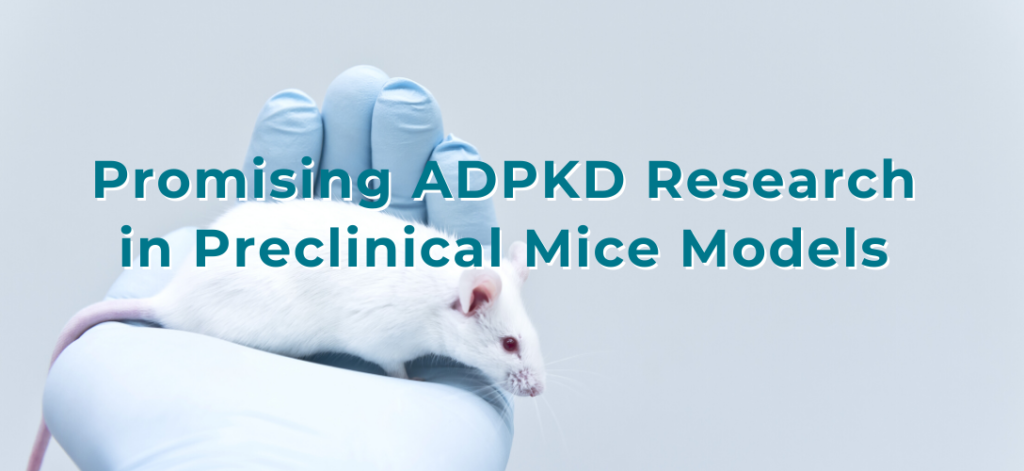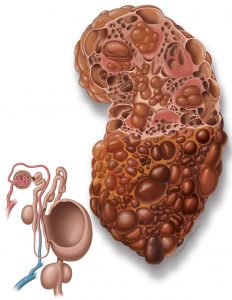 Published on October 19, 2021 | As a genetic disease, ADPKD (autosomal dominant polycystic kidney disease) is caused by mutations in either the PKD1 or PKD2 gene. These genes encode the proteins polycystin-1 and polycystin-2, respectively, which together form the polycystin complex. When there’s a reduction or complete loss of polycystin function, this leads to cyst growth in PKD. While we know that loss of polycystin function leads to ADPKD, ADPKD research hasn’t answered if restoring polycystin function impacts the progression of ADPKD. In a recent study, scientists sought to answer one key question. How does restoring polycystin function impact the progression of ADPKD in mouse models? So far, they’ve seen positive results in reversing ADPKD in mice.
Published on October 19, 2021 | As a genetic disease, ADPKD (autosomal dominant polycystic kidney disease) is caused by mutations in either the PKD1 or PKD2 gene. These genes encode the proteins polycystin-1 and polycystin-2, respectively, which together form the polycystin complex. When there’s a reduction or complete loss of polycystin function, this leads to cyst growth in PKD. While we know that loss of polycystin function leads to ADPKD, ADPKD research hasn’t answered if restoring polycystin function impacts the progression of ADPKD. In a recent study, scientists sought to answer one key question. How does restoring polycystin function impact the progression of ADPKD in mouse models? So far, they’ve seen positive results in reversing ADPKD in mice.
ADPKD Research Mice Models Study
This work was in part funded by a PKDF Investigator Grant in 2014 to Ming Ma, Ph.D., which explored the effects of genetic reactivation of polycystins on the progression of PKD. We are also delighted to have funded Dr. Somlo’s team’s research for many years. In this study, they discovered restoring polycystin function not only slows but reverses ADPKD in this mouse model of disease. That’s incredibly exciting news! This finding is surprising in the capacity of the kidney for plasticity (ability to change), and that this plasticity is in part controlled by the ADPKD genes. Importantly, this work provides a strong rationale for therapeutic approaches to ADPKD aimed at restoring polycystin function.

PKD kidney
Restoring Polycystin Function Early in Progression
To answer the key question, scientists created genetically engineered mice in which the PKD1 or PKD2 gene could be turned off to kickstart the disease and then turned back on. This allowed them to thoroughly evaluate the impact of restoring polycystin function on the progress of ADPKD, both in early and later stages of the disease. Restoring polycystin function early in animals with ADPKD not only slowed disease progression but actually reversed the diseased state. Kidney cysts were largely eliminated, kidney size returned to normal, kidney anatomy and function were restored. Also, overall, kidneys in experimental animals were similar to control animals (in which ADPKD was not induced by kickstarted at all). Other important aspects of ADPKD, including markers of inflammation and fibrosis (tissue damage, scarring), were also reversed with reactivation of polycystin function.
Restoring Polycystin Function Late in Progression
Restoring polycystin later in animals with ADPKD reversed progression of the disease as well. Although, to a lesser degree. As in animals in which polycystin reactivation was performed earlier in disease, cysts were largely eliminated, and kidney size and structure returned to normal. However, inflammation and markers of fibrosis were only partially returned to normal. But this isn’t surprising. Inflammation, and particularly fibrosis, represent damage to the kidneys caused by cyst growth and subsequent damage to the kidney. This damage wouldn’t be expected to be fully reversed when the cysts go away.
Overall, findings provide hope that restoring polycystin function, or “reparative remodeling,” is a viable approach to treating ADPKD. Additionally, results demonstrate the potential to intervene even late in the disease to reverse ADPKD progression. This suggests a wide window of opportunity to intervene—which is ideal.
Understanding the Function of Polycystin
The loss of polycystin not only plays a role in cyst formation and growth but also in the inflammatory and fibrotic aspects of the PKD. This study confirms polycystins play a key role in maintaining and regulating the healthy structure and organization of the kidney. We still don’t fully understand the molecular function of the polycystin complex, but this research provides key insights into the role of polycystin in kidney structure and organization—shaping future research efforts into understanding the molecular function of the polycystins.
Study Limitations
Though this news is exciting, it’s important to remember that findings in mice aren’t directly applicable to treating disease in people. The genetic model used in this study with mice is different than how ADPKD presents in humans. For humans, the genetic cause of ADPKD is heterogeneous, meaning individuals have a wide range of mutations in ADPKD genes. This mouse model is homogenous in both the genetic cause of disease and the timing of polycystin loss. This isn’t the case in humans, and so the results observed in this study are an ideal case.
Reactivation of polycystin function is also homogenous, greater than natural polycystin expression, and occurs in almost all disease cells. Interventions in humans wouldn’t be expected to intervene in all disease cells. That means observations in this model represent a best-case scenario. The most similar approach to treat ADPKD in humans would be add-back gene therapy. However, the PKD1 and PKD2 genes are too large to be delivered by traditional gene therapy. So, this approach currently isn’t a feasible therapy in people either.
For now, it’s not clear how directly translatable these findings are to people with ADPKD.
Advancing ADPKD Research for Potential Therapeutic Treatments
What is the right approach to restore polycystin function in people with ADPKD? In order to answer that question, the PKD Foundation is funding multiple approaches, providing a strong portfolio of projects aimed at restoring polycystin function as a treatment for PKD. A primary function of our grants program is to fund innovative, early research to identify potential therapeutic treatments for PKD that then goes on to apply for larger NIH-funded grants.
Over the past several years, the Foundation funded multiple scientists to evaluate a variety of approaches to restore polycystin function. These grants included:
 2020 Fellowship, Laura Onuchic, M.D.: This project is a gene therapy approach. A gene encoding a portion of polycystin-1 is introduced into kidneys to restore polycystin function.
2020 Fellowship, Laura Onuchic, M.D.: This project is a gene therapy approach. A gene encoding a portion of polycystin-1 is introduced into kidneys to restore polycystin function.
 2020 Investigator Grant, Stephen Parnell, Ph.D.: This project explores the use of a small portion of polycystin-1 as a peptide drug to restore polycystin function.
2020 Investigator Grant, Stephen Parnell, Ph.D.: This project explores the use of a small portion of polycystin-1 as a peptide drug to restore polycystin function.
 2021 Fellowship, Alysia Cox, Ph.D.: This project investigates restoring polycystin function by using targeted delivery of mRNA encoding polycystin-2 to the kidneys. This mRNA technology is similar to what’s used in the Pfizer and Moderna COVID vaccines.
2021 Fellowship, Alysia Cox, Ph.D.: This project investigates restoring polycystin function by using targeted delivery of mRNA encoding polycystin-2 to the kidneys. This mRNA technology is similar to what’s used in the Pfizer and Moderna COVID vaccines.
 2021 Fellowship, Cynthia Sieben, Ph.D.: This project is exploring the use of small molecules drugs that help restore the function of mutated polycystin proteins (known as chaperone therapy) to increase polycystin function.
2021 Fellowship, Cynthia Sieben, Ph.D.: This project is exploring the use of small molecules drugs that help restore the function of mutated polycystin proteins (known as chaperone therapy) to increase polycystin function.
We believe that together, these four approaches provide a broad set of independent therapeutic approaches to making restoring polycystin function a treatment for ADPKD. The future of ADPKD research is exciting and full of hope for new therapeutic treatments. To that end, our $70 million Future Focus campaign—the most ambitious in our 40-year history—aims to increase our research commitment by 300%. Since its launch five years ago we’ve already increased research grant funding by 230%, funding 56 researchers in the past four years alone. Through this campaign and our support of researchers like Dr. Somlo, we continue to usher in new hope in the fight to #endPKD.
Interested in ADPKD and ARPKD research in people? Through our Act Alert program, you can sign up for notifications about ongoing research studies and clinical trials. Choose to receive ADPKD-related alerts or ARPKD alerts. Interested in both? Sign up for both!









Excellent work! I am so happy to know that we are making progress in finding the cure or to reduce the progression of this terrible generic condition. I have a lot of hope in mRNA technology
How are you reversing it in mice ? Is there something humans can do both my husband and daughter have
last section of the article: “The most similar approach to treat ADPKD in humans would be add-back gene therapy. However, the PKD1 and PKD2 genes are too large to be delivered by traditional gene therapy. So, this approach currently isn’t a feasible therapy in people either.
For now, it’s not clear how directly translatable these findings are to people with ADPKD.”
My husband and daughter both have ASPKD, my husband is currently on dialysis and my daughter is 21. Is there anything in the near future with the research for humans and not mice? My daughters Nephrologist is wanting to start her on Tolvaptan but its harsh on the liver so labs will be regularly
Based on the limitations of this study, it’s not clear how directly translatable the findings are to people with ADPKD. However, check out our Research Pipeline (https://pkdcure.org/what-is-pkd/latest-research/pipeline/) or Clinical Studies webpages (https://clinicalstudies.pkdcure.org/questions/) to learn more about research in humans.
Exciting to see all this progress in research. So much great work is being done. Thank you all!
Amazing work! Definitely there is hope for all us with PKD
A great achievement by the scientists where my family has affected by the adpkd i great to find the treatment
This research is tremendously exciting. A wonderful affirmation of the efforts put in by so many people over the years to raise and donate to the PKD Foundation. This is why we do what we do! All of this work on restoring polycystin function will surely bear fruit for our patients in the not-too-distant future. Keep up the great work!
This is terrific research over the past 7 years which also reinforces just how much more knowledge we need to gain relative to the mechanisms that cause PKD and just how complex these mechanisms are to control. The differences between rodent models and human models also reinforces the need for all those afflicted with PKD to participate in human studies and trials. Lastly, the major hurdle in the race for treatments and a cure is primarily an issue of more funding for the super-smart research scientists around the world studying PKD – we’ve got to be successful in our campaigns to raise and deploy funding for additional research to cut the timeline for development of effective treatments. Along with my fellow PKD sufferers, I am committed to do my part to support all these efforts. If you’re so inclined, please support next Summer’s RideForPKD (www.rideforpkd.org), a 5300 mile, 120-day bike ride across America to raise $500,000 for PKD research funding through the PKD Foundation. Thank you, Glenn Frommer (lead rider for RideForPKD)
This is wonderful news!
Let’s hope this will help in the work being done for humans.
Thanks to all of the brilliant people working on this! 💕💕
I’m very excited that there is new breakthroughs in the fight to find a cure for PKD…which I have as well as my daughter and sister. How do I find out about the RiseForPKD? I am an avid bike rider. Leon Springer ljspringer16@gmail.com
When the new medicine o treatment be in the pharmacy o the doctor can used the treatment for the patient.
Me too waiting but don’t know when in recent generations or for future generations.
Really interested to see progress on use of mRNA approaches to PKD given the recent Moderna first patient infusion for Glycogen Storage Disease.
My father in-law had PKd who has passed away after being on dialysis for 13 years. My wife has PKD now. My kids are small and i am worried that both the kids would also have PKD. Is there any hope for getting cure for this disease in near future?
We have more drugs in the treatment pipeline today than ever before and are encouraged by the progress being made. You can learn more about those potential treatments here – https://pkdcure.org/what-is-pkd/latest-research/pipeline/. While we continue to fund and support research for a cure, we also encourage you to participate in clinical studies and the ADPKD Registry to help progress that research.